
The performance improvement services provided by Practus assisted the Bank in understanding the impact of costs at various levels and enabled faster pricing decision-making.
| Client Name | ROI | Industry | Ownership | Management | No. of Employees | Size | Project Duration |
| A Loan Banking Company | 4.8x | NBFC | Majority PE Owned | Professional | 50-250 | <$10 million | 40 months |
About The Company
Loan Mate is a company operating in the unsecured financing space. The company is principally engaged in providing unsecured loans to people who cannot access the normal banking channels. Practus has been involved with this company for the last 12 months.
Practus’ Role in Performance Improvement Services
- Revenue streams and Fixed costs were identified.
- Costs were also split into discretionary (specific marketing costs) and non-discretionary and as direct and indirect.
- Introduced the concept of actual (accounting based on accrual) and notional (notional cost of equity/capital) costs which allowed the company to track the P&L based on both the aspects.
- Introduced a 3-level margin analysis (a) gross margin (interest income minus interest expense) (b) gross margin 2 (gross margin minus direct cost involving business development costs as well as notional provision for NPA/bad debts) and (c) gross margin 3 (gross margin 2 minus corporate overheads).
- Costing at a customer or portfolio level allowing the company to track profitability at a salesperson/DSA level.
Impact Delivered in Performance Improvement Services
- Complete alignment on the definition of how business performance would be measured (borrower, portfolio, geography, channel, and company level) and in pursuing discussions with the CEO and business heads.
- Multiple cost dimensions allowed the company to tag the costs at a transaction level thereby making it easy to slice and dice costs across various dimensions. Assisted in setting clear ‘cost reduction’ targets.
- Customer and portfolio profitability allowed the company to make decisions on to lend or to invest the funds into liquid mutual funds which eventually gave ‘margins’ of 8%.
- The notional P&L allowed the company to track performance based on ‘Cost of capital’ or ‘Opportunity cost’.
- The 3-level margin analysis allowed the management to understand the impact of costs at various levels at any given point in time and helped to decide the pricing and take quicker decisions without the need to check with the head office.



